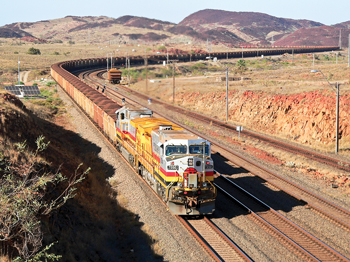|
The locals insisted that I should see the train before I left Dampier. More on the train later, but as for Dampier, to describe this isolated outpost as lacking any semblance of cosmopolitan chic is to say Einstein may have known a thing or two about physics.
Located on the edge of the Outback, Dampier looks to be no more than a barren depository for red rock on Australia’s northwestern coast. However, for the past few years, it also has been a boom town. It was during a day trip in early 2008, while on an assignment in Perth, that I saw first-hand the strategic position this windswept hinterland occupies in Australia’s oil and gas industry. The Port of Dampier is the solitary supply base for the Northwest Shelf and growing Western Australia onshore exploration sector.
Unfortunately for drillers, Dampier also is situated in the heart of the legendary Pilbara Range, which holds perhaps the largest veins of iron ore and other metals. Dampier, in fact, was actually created in 1965 specifically to service the giant Hemersley Iron mining company. The insatiable demand for copper, nickel, silver and other metals used in consumer electronic products, as well as iron ore needed to feed the construction frenzy in the still emerging economies of China and elsewhere, has created an ever-increasing hunger for all things metallic. Consequently, the mines along the Pilbara Range and throughout Australia have long been operating at maximum capacity.
In Australia, the mining industry is at the top of the food chain, the first in line for port space and anything else required to meet the incessant global demand. Therein lies the corner into which Australian drillers find themselves backed, and which brings us back to the train.
The folks in Dampier boasted that the train was the world’s longest and could be seen most every day ferrying untold tons of iron ore from Pilbara mines to the port. Before dismissing their claims as so much braggadocio, I decided to have a look. Let’s just say if a more elongated cargo hauler existed, I would not want to be the one responsible for operating the tape measure. The train had no end in sight and was fully loaded with ore from the Pilbara mines. Obviously, the extraction and transportation of such colossal tonnage requires enormous resources of both supplies and people, especially people.
For the past few years, the personnel demand has produced quite a pickle for Australia’s expanding oil and gas industry. While offshore drilling declined slightly over the past year, onshore exploration and development, particularly in the tight gas sector, is accelerating rapidly. When combined with world-class LNG developments, this activity has resulted in unprecedented oil and gas investments totaling well over $100 billion, says the Australian Petroleum Production and Exploration Association (APPEA).
 |
| The world’s supposedly longest cargo train is reflective of the labor woes affecting Australia drillers. |
|
In July 2010, the National Resources Sector Employment Taskforce (NRSET) concluded that with Australia’s unemployment rate dropping some 31% in a year, “competitive and timely access” to labor is at an all-time premium. “Australia’s oil and gas industry is already investing heavily in local training opportunities, but our industry needs more people and more skills, if we are to capitalize on the enormous opportunities that our extraordinary gas endowment represents,” says APPEA.
The operative word is “competitive,” which may prove to be the most daunting barrier to actually attracting the thousands of oilfield workers required, especially considering that the industry has to compete heads-up with Australia’s booming mining sector. Mining/oil company BHP estimated in 2011 that the mines would need more than 170,000 new jobs over the next five years. Compounding the problem for drillers is that when comparative salaries for laborers are included in the equation, they typically find themselves behind the proverbial eight-ball.
According to the Wall Street Journal, the mining boom has spawned a class of nouveau riche among non-degreed mine workers. In a Nov. 16 article, the WSJ profiled a 25-year-old high school dropout, who was pulling down more than $200,000 a year working in the underground mines of Western Australia. While I personally would much rather breathe fresh air on a rig floor than spend my days buried under tons of rock, trying to persuade a starry-eyed young chap that being a entry-level roustabout at a fraction of the salary is preferable to the comparative riches that the mines offer is a hard sell.
As the manager of one service company told me nearly four years ago in Perth, while the double mining and oilfield boom is a blessing for the Australian economy, sometimes one can have too much of a good thing. 
|





